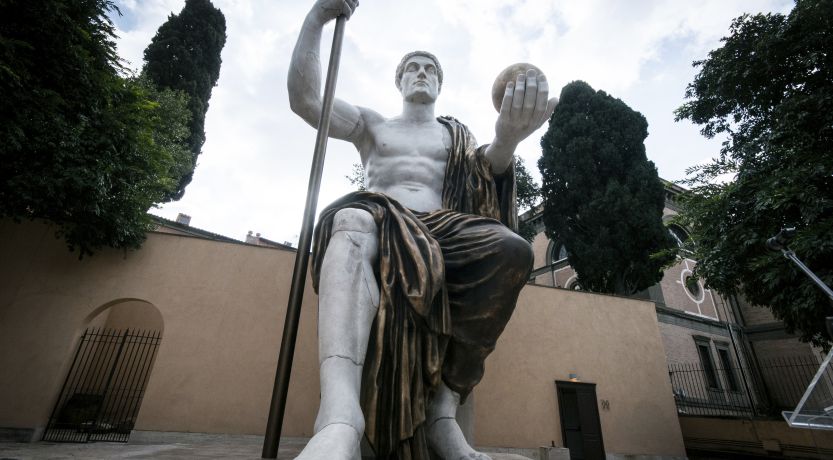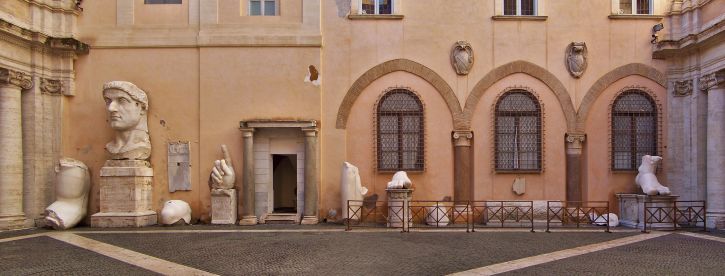Constantine and the Push to Resurrect an Empire
Is an ancient empire about to be resurrected again? Learn about recent developments to restore the glory of ancient Rome and what it means for you.

The new statue of Constantine the Great displayed on the grounds of the Capitoline Museums in Rome, Italy.
A large statue of Emperor Constantine the Great was recently erected in Rome. This statue is a to-scale replica of a statue that stood in Rome in the days of Constantine himself.
Using photogrammetry, the ancient statue was reconstructed by scanning the surviving fragments. The scan produced a digital 3D model that filled in the missing parts, allowing for a life-size reconstruction of the original statue.
The reconstruction of a statue of this specific emperor is noteworthy for students of both history and prophecy.
Why was Constantine and the empire he led so significant?
The man who transformed an empire
Constantine was born sometime between A.D. 272 and 285 in Naissus, in modern-day Serbia. He rose to become the sole emperor of the Roman Empire when, as a military general, he emerged the victor of a civil war against two competing emperors, Maxentius and Licinius.
He is well-known today for his radical transformation of the Roman Empire by adopting and legalizing Christianity, the religion the empire had ruthlessly persecuted. As a result, Roman Christianity became the empire’s dominant religion.
How did this occur?
According to the historian Eusebius, Constantine sought help to outmatch and defeat his rival Emperor Maxentius at the Battle of Milvian Bridge.
Constantine in pieces. The remaining fragments of the Colossus of Constantine statue displayed at the Capitoline Museums in Rome, Italy (source: Wikimedia Commons/CC BY-SA 2.5 ca).
Constantine apparently made his soldiers paint these two Greek letters, “chi” (shaped like X) and “rho” (shaped like P), on their shields before they fought. He credited his triumph over Maxentius and his subsequent rise as the sole emperor to Christ, who he believed was the source of the vision that guided him.
With Constantine’s help, a form of Christianity known as the Roman Catholic (or Universal) Church rose to prominence in the fourth century. However, this emerging church looked nothing like the one Jesus founded in the first century. Many of the doctrines and practices it developed were foreign to the biblical record. (To learn more, read “Church History: Constantine, an Emperor Who Defied God.”)
Along with the large statue of Constantine, other cultural aspects of the Roman Empire are being revived today, including an ancient map displayed in a new museum. But it’s not just its cultural aspects that are getting a revival. Powerful forces continue to push the continent’s political and military institutions to revive this ancient empire.
A push from the east
Russia’s ongoing incursion into Ukraine and saber-rattling against the West has prodded Europe to diversify its energy sources and take the defense of the continent more seriously.
Consider the following headlines:
- “Macron Says ‘Nothing Ruled Out,’ Including Using Western Troops, to Stop Russia Winning Ukraine War” (Feb. 27, 2024).
- “How Russia Pushed Finland and Sweden to Join NATO” (Feb. 27, 2024).
- “German, Danish Leaders Launch Construction of New Ammunition Plant as Europe Ramps Up Production” (Feb. 12, 2024).
- “Germany to Permanently Deploy Troops for First Time Since World War II” (Dec. 18, 2023).
- “EU Looks to the Middle East to Replace Russian Gas Imports” (May 26, 2022).
- “Germany to Increase Defence Spending in Response to ‘Putin’s War’—Scholz” (Feb. 27, 2022).
Ironically, Russia’s push into Ukraine, which itself is in response to NATO’s eastward expansion, is accelerating European military growth and rearmament.
To learn more, read “Will the Crisis in Ukraine Lead to a European Military?”
A push from the West
Political unrest across the Atlantic, primarily in the United States, is forcing Europe to work toward greater military independence.
In the wake of World War II’s utter destruction, Europe was left in a harrowing position. With Russia pushing from the east, the United States provided a military security umbrella for Europe through NATO to prevent Russia from advancing further into the continent.
After the fall of the Soviet Union, Russia retreated east, leaving the eastern nations that were formerly in the Soviet sphere to gravitate toward the West. While the United States was strong and bankrolled its security, Europe enjoyed economic prosperity without having to worry about high military expenditure.
Political unrest across the Atlantic, primarily in the United States, is forcing Europe to work toward greater military independence.
Today, things are different. The United States is under a heavy debt burden and is slowly withdrawing from the world scene, allowing other great powers, namely Russia and China, to rise and fill the void. Russia is pushing again into Europe, and NATO’s security umbrella doesn’t look as strong as it once did.
Now, two troubling factors are raising concern in Europe.
First, there are political divisions in the United States over the Ukraine-Russia war. The United States does not seem committed over the long term to supporting Ukraine in its war against Russia. The population has lost its appetite for sending vast amounts of money to fund an overseas war that poses no immediate threat to the United States. With so many problems at home, many Americans see better uses for that spending.
The second major reason is the political future in the United States. On numerous occasions former President Donald Trump, who is leading in many national polls, has voiced his distaste for the United States’ continual bankrolling of NATO and of Ukraine’s war effort. He has pushed for European NATO countries to increase their military spending to the agreed figure of 2 percent of GDP. He recently put doubts in European leaders’ minds whether the United States under his leadership would fight to defend certain NATO allies.
These factors have led Europe to begin to build military independence from the United States. In April of 2023, French President Emmanuel Macron called for Europe to strive for “strategic autonomy” from the United States and become a “third superpower” (along with China).
The recent Red Sea mission to protect the shipping lanes from Houthi attacks is a case in point. In late 2023, the United States led a coalition of nations, dubbed Operation Prosperity Guardian, to the Red Sea. Notably, Spain, Italy and France refused to go under the U.S. command. Instead, the Europeans launched their own mission to the Red Sea, Operation Aspides (Greek for “shield”).
For further insight about these trends, read “Will NATO Survive?”
A push from the south
The recent Israel-Hamas war has changed the dynamics in the Middle East.
Due to geography and fossil fuel production, instability in this region directly affects Europe. In addition, recent immigration influxes from the Middle East and Africa have caused political and social instability in many European nations.
Europe cannot afford for the Middle East to fall apart.
As such, Europe has recently become far more involved in the affairs of this region, and some are pushing for Europeans to take an even more assertive stance. Consider the following headlines:
-
The Bible foretells a revived Roman Empire rising just before Christ’s return.
“Top EU Diplomat Says Israel Has No Right to Block Creation of Palestinian State” (Jan. 23, 2024). - “Germany Rewards Saudi Arabia for Its ‘Constructive’ Israel Stance by Lifting Arms Export Ban” (Jan. 8, 2024).
- “EU Foreign Policy Chief Borrell Warns It Is ‘Imperative’ Lebanon Is Not Dragged Into War” (Jan. 6, 2024).
Recent provocations from the Houthis include cutting communication cables from Asia to Europe. Their direct warning to the European Union against “playing with fire” will inevitably force Europe to become more involved.
The Bible warns of a dramatic attack, a “push” from the region that will force the revived Roman Empire in Europe to retaliate with an overwhelming force described as a “whirlwind”—“with chariots, horsemen, and with many ships” (Daniel 11:40). This describes an utterly overwhelming retaliation to an unprovoked attack by the air, land and sea.
These events take place in the final years just before Christ’s return, which will come just in time to stop us from destroying ourselves through endless warfare.
To learn more, read “The King of the South.”
A push from within
The Bible foretells a revived Roman Empire rising just before Christ’s return. Students of history and Bible prophecy understand that the Roman Empire has had nine resurrections so far and that one final revival is to come.
However, this final rise will differ from the Europe we see today. That’s why we shouldn’t be surprised that the forces pushing from the east, west and south are forcing Europe to change. That change will continue until Europe finally morphs into its final form as an end-time superpower.
The empire over which Constantine ruled nearly 17 centuries ago will arise again.
In recent months, Europe has debated making changes to its governance, which has been described as “the most dramatic systemic transformation since its inception.” Changes include limiting the number of EU commissioners and eliminating the veto right currently held by each member country. This will result in power being concentrated in the two biggest EU nations: France and Germany.
Another change is removing the stigma of Germany becoming a military power and possibly even a nuclear power. One of the original purposes of the EU was to prevent Germany from rising again and causing another world war. Now Germany finds itself remilitarizing.
German Defense Minister Boris Pistorius has warned Europe that “we could be facing dangers by the end of this decade” and that Germany must be “ready for war.” There is now an ongoing discussion in Germany about developing nuclear weapons, a topic that would have been taboo just a few decades ago.
In 2011, Polish Foreign Minister Radoslaw Sikorski said, “I fear Germany’s power less than her inactivity.”
Keep watching Europe
Christians should watch the external and internal pressures molding Europe—especially Germany—toward reviving an ancient empire. The ancient Roman Empire ruled the world of its day with a military force powerful enough to subjugate millions of people and large stretches of land.
When this empire rises again in our day, the world will marvel at its restored military strength, saying, “Who is like the beast? Who is able to make war with him?” (Revelation 13:4).
The empire over which Constantine ruled nearly 17 centuries ago will arise again.
The good news is that this revived Roman Empire will last for only a very short time. Its rule will be destroyed when Jesus Christ returns to replace it with His Kingdom on this earth.
Date Posted: April 1, 2024



